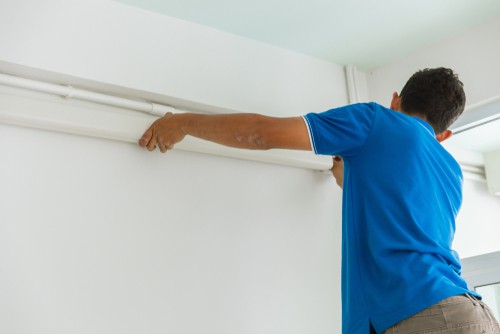Why Think About Hidden Piping in False Ceilings?
· Visual Appeal:
Concealed pipework creates a smooth and clean appearance by hiding ugly pipes and ducts. This is especially significant in residential, commercial, or office settings where design is essential to establishing a welcoming atmosphere.
· Optimization of Space:
By concealing the air conditioning ducts, wiring, and piping, false ceilings increase the amount of visible height and provide the impression that there is less clutter. This is particularly helpful in small spaces where making the most of available space is crucial.
· Improved Protection:
Pipework that is exposed is more susceptible to corrosion, wear and tear, and unintentional damage. The pipes are longer-lasting because they are better shielded from the elements by being set in a false ceiling.
· Reduction of Noise:
In systems where refrigerant movement might be somewhat audible, the false ceiling serves as a buffer to reduce the noise produced by air conditioning pipes.
Concealed Piping Planning:
To guarantee optimum performance and aesthetics, meticulous planning is necessary before updating your air conditioning system.
· Evaluation of Design:
Work together with an HVAC specialist or interior designer to plan where the air conditioners, piping, and false ceiling will go. A design plan guarantees effective placement without interfering with the arrangement of the space.
· Load Calculations:
Ensure that the space is effectively cooled by the current air conditioning unit when it is connected to concealed piping. Inadequate cooling may result from inaccurate load estimations.
· Material Selection and Pipe Positioning:
For durability, high-quality materials should be used, such as copper pipes for refrigerant lines. Plan the placement to minimize the length of the pipelines, thereby reducing refrigerant loss and ensuring efficiency.
· Selecting A False Ceiling:
The type of false ceiling material—such as plasterboard, PVC, or gypsum board—will have an impact on maintenance, convenience of installation, and thermal insulation. Make sure the material can sustain the weight of ducts and pipes that are hidden.
Benefits of Concealed Piping:
- Increased Efficiency: The refrigerant lines are less affected by outside environmental elements like sunshine and humidity when piping is hidden under a false ceiling. This increases cooling efficiency and decreases energy waste.
- Durability and Longevity: A false ceiling shields pipes from outside harm, extending the system’s lifespan and lowering maintenance needs.
- Cost-Effectiveness: By lowering wear and tear, energy loss, and the need for regular repairs, concealed pipes can result in long-term savings even though the original expenditure may be larger.
- Increased Property Value: By displaying a sleek and contemporary design, a concealed air conditioning system raises the market appeal of residential and commercial properties.
Challenges in Installing Concealed Piping:
Despite its benefits, hidden pipework has certain drawbacks that need to be taken into consideration:
- High Initial Costs: Compared to conventional air conditioning installations, the cost of materials and labor for installing a false ceiling and hidden piping may be greater.
- Space Requirements: Rooms with low ceilings may find false ceilings unsuitable as they lower the room’s effective height.
- Upkeep Accessibility: When pipes and ducts are hidden, it becomes more difficult to reach them for maintenance. Designing maintenance openings or panels for simple examination and repair is crucial.
- Condensation Problems: Poor insulation or poorly installed refrigerant lines may cause condensation to accumulate inside the false ceiling, which may result in water leaks and possible damage to the ceiling.
Tips for Concealed Air Conditioning System Maintenance:
- Frequent Inspections: To spot any problems like refrigerant leaks or insulation damage, routinely check the piping and air conditioning system.
- Filter Cleaning: To maintain ideal airflow and cooling effectiveness, make sure air filters are cleaned or replaced on a regular basis.
- Drainage Line Maintenance: To avoid water accumulation and leakage, clear the condensate drain line.
- Expert Servicing: To ensure that the concealed system is operating effectively and extending its lifespan, schedule yearly expert maintenance.
When Should Concealed Piping Be Considered?
In the following situations, it is best to replace your air conditioning system with concealed piping:
- During undertakings that involve significant renovations or new construction.
- While replacing an outdated air conditioning system with a more contemporary and effective one.
- For areas that need to be more aesthetically pleasing and practical.
Using concealed pipework in a false ceiling to replace your air conditioning system provides the ideal balance of durability, efficiency, and aesthetics. The long-term advantages greatly exceed the difficulties, even though the initial installation could need meticulous preparation and financial investment. A stylish, effective, and trouble-free air conditioning system that improves your home or place of business can be yours with careful design, material selection, and routine maintenance.
Frequently Asked Questions:
1. Can A Refrigerant Problem Be Indicated By Water Leaks?
Indeed, a refrigerant issue may occasionally be indicated by water leakage. The evaporator coil freezes due to low refrigerant levels. Leaks may result from the ice melting and overflowing the drain pan. For the system to operate efficiently, refrigerant problems must be resolved quickly.
2. How Does The Drain Pan Help With Water Management?
Condensation from the evaporator coil is collected by the drain pan and sent to the condensate drain line. Water may seep into the surrounding area if the pan is misplaced, rusty, or damaged. Examine and swap out any damaged drain pans as necessary.
3. How Can I Keep My Air Conditioner From Accumulating Water?
By routinely cleaning or changing air filters, checking and clearing the drain line, making sure pipes are properly insulated, and planning regular HVAC maintenance, you may avoid water buildup. These actions reduce the possibility of water damage and leaks.


